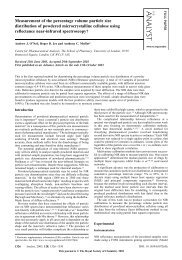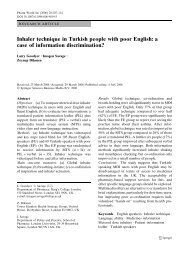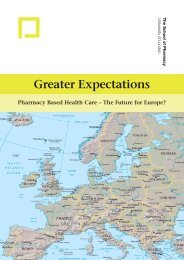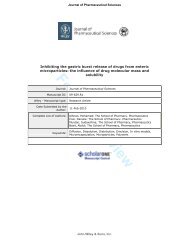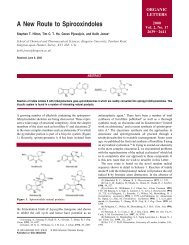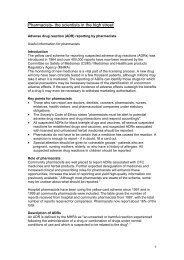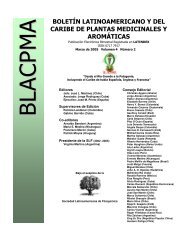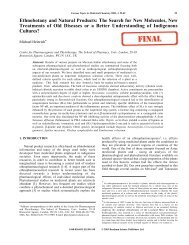SynArfGEF is a guanine nucleotide exchange ... - Pharmacy Eprints
SynArfGEF is a guanine nucleotide exchange ... - Pharmacy Eprints
SynArfGEF is a guanine nucleotide exchange ... - Pharmacy Eprints
Create successful ePaper yourself
Turn your PDF publications into a flip-book with our unique Google optimized e-Paper software.
Vectors<br />
Mammalian expression vectors for synArfGEF (pCAGGS-FLAG-synArfGEF) and GEP100/BRAG2<br />
(pCAGGS-FLAG-GEP100) were made by amplifying the coding regions of rat synArfGEF and<br />
mouse GEP100 using PCR with primers containing EcoRI restriction sites (underlined) as follows:<br />
sense, 5’-GAATTCATGGAGAGCCTGCTGGAGAACCCGG-3’ and ant<strong>is</strong>ense, 5’-<br />
GAATTCCTACACCAGGCTCCTGGAGCCACTG-3’ for synArfGEF; sense, 5’-<br />
GAATTCATGCTAGAACGCAAGTATGGGGGAC-3' and ant<strong>is</strong>ense, 5’-<br />
GAATTCTTAGGAGCACAGCACTGGAGGCTG-3’ for GEP100. After subcloning into pGEM-T<br />
Easy (Promega, Mad<strong>is</strong>on, WI), the cDNA fragments were digested with EcoRI and ligated into the<br />
same restriction site of pCAGGS-FLAG (Sakagami et al. 2005, Niwa et al. 1991). A mammalian<br />
expression vector for IQ-ArfGEF/BRAG1, pCAGGS-FLAG-IQ-ArfGEF/BRAG1, was described<br />
previously (Sakagami et al. 2008). The expression vectors for S-SCAM (pCIneoMyc S-SCAM (1-<br />
1277), (1-301), (295-578), (423-578)) were described previously (Sumita et al. 2007). The<br />
expression vectors for C-terminally hemagglutinin (HA) epitope-tagged Arf1 and Arf6 in pcDNA3<br />
(Hosaka et al. 1996) were kindly provided by Dr. Kazuh<strong>is</strong>a Nakayama (Kyoto University). The<br />
expression vector for C-terminally FLAG-tagged Arf6(Q67L) mutant in pcDNA3 (Tanabe et al.<br />
2005) was kindly provided by Dr. Masanobu Satake (Tohoku University).<br />
For Arf pull down assays, the bacterial expression vector containing the GAT domain of GGA1<br />
(Golgi-localizing, γ-adaptin ear homology domain, Arf-binding protein 1) (Shinotsuka et al. 2002)<br />
was kindly provided by Dr. Kazuh<strong>is</strong>a Nakayama (Kyoto University).<br />
For pMAL-SXN, a bacterial expression vector that has the same reading frame for the SalI cloning<br />
site as that of pGEX4T-2 (GE Healthcare, P<strong>is</strong>cataway, NJ, USA), oligo<strong>nucleotide</strong>s containing SalI,<br />
XhoI and NotI sites (5’-AATTGTCGACTCGAGCGGCCGCTGCA-3’ and 5’-<br />
GCGGCCGCTCGAGTCGAC-3’) were annealed and ligated into the EcoRI and PstI sites of pMAL-<br />
c2 (New England Biolabs, Beverly, MA, USA). To prepare antigens for immunization and affinity<br />
purification, the N-terminal region (amino acids 1-293) of rat synArfGEF, the entire coding region of<br />
mouse gephyrin, the region between PDZ1 and PDZ2 domain of rat S-SCAM (amino acids 510-<br />
570), the region containing 13th and 14th spectrin repeats of mouse utrophin (amino acids 1761-<br />
2101) were amplified by PCR with the following primers containing a SalI site (underlined) in sense<br />
primers and a stop codon (small letters) in ant<strong>is</strong>ense primers: 5’-<br />
GTCGACCATGGAGAGCCTGCTGGAGAACCCGG-3’ and 5’-<br />
ctaTAGGTCAAGGGAGAGTTCGTACTC-3’ for synArfGEF;<br />
GTCGACCATGGCGACCGAGGGAATGATCCTCAC-3’ and<br />
tcaTAGCCGTCCAATGACCATGACATC-3’ for gephyrin; 5’-<br />
GTCGACCTGTCGTGGCTACCCTTTGCCCTTTG and<br />
5’ctaGTGCAAAGAATGAGGTGGCCGGTCTG-3’ for S-SCAM; 5’-<br />
GTCGACGACCCTGCTGGAACTGTTCAAGCTGC-3’ and 5’-<br />
ttaCGTTAACCAGCAGGTGACCTCATCTAGCC-3’ for utrophin. After subcloning into pGEM-T



